Influence of Gas Inlet Slit Width on Gas-Assisted Plastic Micro-Tube Extrusion
Abstract
1. Introduction
2. Numerical Simulation Theory and Model Setting
2.1. Control Equations and Constitutive Equations
2.2. Geometric and Finite Element Models
2.3. Numerical Simulation Parameters
2.4. Boundary Conditions Setting
- (1)
- The flow boundary is set as follows:
- (2)
- The thermal boundary is set as follows:
2.5. Numerical Simulation Method
3. Simulation Results and Analysis
3.1. Micro-Tube Size Distribution
3.2. Velocity Field Distribution
3.3. Distribution of Shear Rate
3.4. Pressure Field Distribution
3.5. Temperature Field Distribution
4. Experimental Section
5. Conclusions
Author Contributions
Funding
Data Availability Statement
Conflicts of Interest
Nomenclature
| ∇ | Hamiltonian |
| ρk | density |
| νk | velocity vector |
| pk | pressure |
| τk | bias stress tensor |
| CV | specific heat capacity |
| Tk | temperature |
| qk | thermal conductivity |
| viscous dissipation term | |
| τr | melt stress tensor |
| τ1 | elastic component of the melt bias stress tensor |
| τ2 | viscous component of the melt bias stress tensor |
| η12 | Newtonian viscosity component of the melt |
| η1 | total viscosity of the melt |
| η1r | viscosity ratio of the melt |
| λ | relaxation time |
| ε | material intrinsic parameter for the tensile properties of the melt |
| ξ | material intrinsic parameter for the shear properties of the melt |
| D | deformation rate tensor |
| P1 | gas pressure |
| ρ1 | gas density |
| T1 | gas temperature |
| R | gas constant (R = 287 (J·kg−1·K−1)) |
| fn | normal stresses on boundary surface |
| fs | tangential stresses on boundary surface |
| vR | normal velocities at the boundary surface |
| vZ | tangential velocities at the boundary surface |
| W | width of the gas inlet slit |
References
- Liu, T.K.; Huang, X.Y.; Liu, H.S.; Ren, Z.; Luo, C.; Wang, D.Y. Effect of air on interior air cushion of plastic microtube gas assisted extrusion. Polym. Mater. Sci. Eng. 2020, 36, 75–86. [Google Scholar]
- Ren, Z.; Huang, X.Y.; Liu, H.S. Influence of gas in interior air cushion layer in gas-assisted extrusion of plastic micropipes. Mater. Guide 2020, 34, 20193–20198. [Google Scholar]
- Liu, B.; Huang, X.; Ren, S.; Luo, C. Effect of Pressure Difference between interior and exterior Gas Layer on Micro-Tube Deformation during Gas-Assisted Extrusion. Polymers 2022, 14, 3559. [Google Scholar] [CrossRef] [PubMed]
- Jin, G.B.; Zhao, D.Y.; Wang, M.J.; Jin, Y.F.; Tian, H.Q.; Zhang, J. Study on design and experiments of extrusion die for polypropylene single-lumen micro tubes. Microsyst. Technol. 2015, 21, 2495–2503. [Google Scholar] [CrossRef]
- Tang, D.; Fang, W.L.; Fan, X.H.; Li, D.Y.; Peng, Y.H. Effect of die design in microchannel tube extrusion. Procedia Eng. 2014, 81, 628–633. [Google Scholar] [CrossRef]
- Jin, G.B. Research on Design and Manufacturing Technology and Extrusion Process of Polymer Micro-Extrusion Die for Interventional Medical Catheters. Ph.D. Thesis, Dalian University of Technology, Dalian, China, 2013. [Google Scholar]
- Zhu, C.W.; Wu, D.M. The design of the die for Multi-lumen precision medical catheter. Plastics 2008, 37, 99–102. [Google Scholar]
- Chen, X. The Research of Technology and Die in Continuous Extrusion of Microcellular Plastics. Ph.D. Thesis, Nanchang University, Nanchang, China, 2014. [Google Scholar]
- Zhang, H.G.; Lamnawar, K.; Maazouz, A.; Maia, J.M. A nonlinear shear and elongation rheological study of interfacial failure in compatible bilayer systems. J. Rheol. 2016, 60, 1–23. [Google Scholar] [CrossRef]
- Luo, X.L.; Mitsoulis, E. Memory phenomena in extrudate swell simulations for annular dies. J. Rheol. 1989, 33, 1307–1327. [Google Scholar] [CrossRef]
- Yao, D.; Kim, B. Simulation of the filling process in micro channels for polymeric materials. J. Micromech. Microeng. 2002, 12, 604–610. [Google Scholar] [CrossRef]
- Liu, K.; Wang, M.J.; Zhao, D.Y.; Li, H.X. Viscoelastic rheological properties of polymer melts in cross-scale extrusion processes. China Mech. Eng. 2021, 32, 1494–1503. [Google Scholar]
- Wang, M.J.; Tian, H.Q.; Zhao, D.Y. Micro-scale shear viscosity testing approach and viscosity model of polymer melts. J. Mech. Eng. 2012, 48, 21–29. [Google Scholar] [CrossRef]
- Xiao, X.H. Analysis and Experimental Study of Polymer Micro Tubing Extrusion Flow. Ph.D. Thesis, Central South University, Changsha, China, 2013. [Google Scholar]
- Xiao, J.H.; Chen, S.W. Rheological properties of medical grade thermoplastic polyurethane. Polym. Mater. Sci. Eng. 2016, 32, 87–90. [Google Scholar]
- Zhao, D.Y.; Wang, M.J.; Song, M. Experimental study and molecular dynamics simulation of wall slip in a micro-extrusion flowing process. Mech. Eng. Sci. 2012, 225, 1175–1190. [Google Scholar] [CrossRef]
- Wei, Y.B.; Wang, M.J.; Zhao, D.Y.; Liu, K.; Shen, Z.N. Study on single-die multi-specification polylactic acid microtube extrusion molding process. Polym. Mater. Sci. Eng. 2019, 35, 95–102. [Google Scholar]
- Jin, G.B.; Wang, M.J.; Zhao, D.Y.; Tian, H.Q. Experimental investigation of extrusion process of double-lumen micro tube. J. Mech. Eng. 2012, 48, 19–27. [Google Scholar] [CrossRef]
- Wang, L. Study on Extrusion Molding and Processing Parameters of Polymeric Microtubes with Rectangular Microchannels. Ph.D. Thesis, Zhejiang University, Hangzhou, China, 2020. [Google Scholar]
- Mu, Y.; Zhao, G.Q.; Wu, X.G.; Zhai, J.Q. Finite-Element Simulation of Polymer Flow and Extrudate Swell Through Hollow Profile Extrusion Die with the Multimode Differential Viscoelastic Model. Adv. Polym. Technol. 2013, 32, 1–19. [Google Scholar] [CrossRef]
- Zhao, L.Z. Research Progress in Extrusion Swell of Polymer Melt. China Plast. 2007, 21, 1–5. [Google Scholar]
- Mu, Y.; Zhao, G.Q.; Zhang, C.R. Numerical Investigation of Viscoelastic Flow and Swell Behaviors of Polymer Melts in the Hollow Profile Extrusion Process. Adv. Mater. Res. 2010, 97, 209–213. [Google Scholar] [CrossRef]
- Xu, X.M.; Zhao, G.Q.; Qin, S.X.; Wang, W.W. Numerical Simulation of Viscoelastic Extrudate Swell Through Elliptical Ring Die. Chin. J. Chem. Eng. 2011, 19, 10–17. [Google Scholar] [CrossRef]
- Ren, Z.; Huang, X.Y.; Xiong, Z.H. Experimental and numerical studies for the gas-assisted extrusion forming of polypropylene micro-tube. Int. J. Mater. Form. 2020, 13, 235–256. [Google Scholar] [CrossRef]
- Yin, H.N.; Huang, X.Y.; Liu, T.K.; Song, M.J. Effects of gas-assisted extrusion on slip in the cable coating process. J. Polym. Eng. 2021, 41, 329–337. [Google Scholar] [CrossRef]
- Huang, X.Y.; Liu, H.S.; Zhou, G.F.; Luo, Z.M.; Li, S.Y. The Experimental Study of Air-Assisted Extrusion of Polymer. China Plasitics 2005, 19, 17–19. [Google Scholar]
- Luo, C.; Huang, X.Y.; Liu, T.K.; Liu, H.S. Research on interior Gas Inflation Improvements in Double-layer Gas-assisted Extrusion of Micro-tubes. Polymers 2020, 12, 899. [Google Scholar] [CrossRef]
- Huang, C.Y.; Liu, H.S.; Huang, X.Y.; Wan, Q.F.; Ren, Z. Numerical Simulation of Gas-assisted Extrusion Process of Microtube. China Plast. Ind. 2015, 43, 44–48. [Google Scholar]
- Liang, R.F.; Mackley, M.R. The gas-assisted extrusion of molten polyethylene. J. Rheol. 2001, 45, 211–226. [Google Scholar] [CrossRef]
- Ren, Z.; Huang, X.Y.; Liu, H.S.; Deng, X.Z.; He, J.T. Non-isothermal viscoelastic numerical analysis of compressible gas-assisted polymer extrusion molding. CIESC J. 2015, 66, 1615–1623. [Google Scholar]
- Ren, Z.; Huang, X.Y.; Liu, H.S.; Deng, X.Z.; He, J.T. Numerical and experimental studies for gas assisted extrusion forming of molten polypropylene. J. Appl. Polym. Sci. 2015, 132, 1–13. [Google Scholar] [CrossRef]
- Liu, T.K.; Huang, X.Y.; Luo, C.; Wang, D.Y. The Formation Mechanism of the Double Gas Layer in Gas-Assisted Extrusion and Its Influence on Plastic Micro-Tube Formation. Polymers 2020, 12, 355. [Google Scholar] [CrossRef]
- Phan, T.; Tanner, R. A new constitutive equation derived from network theory. J. Non-Newton. Fluid Mech. 1977, 2, 353–365. [Google Scholar]

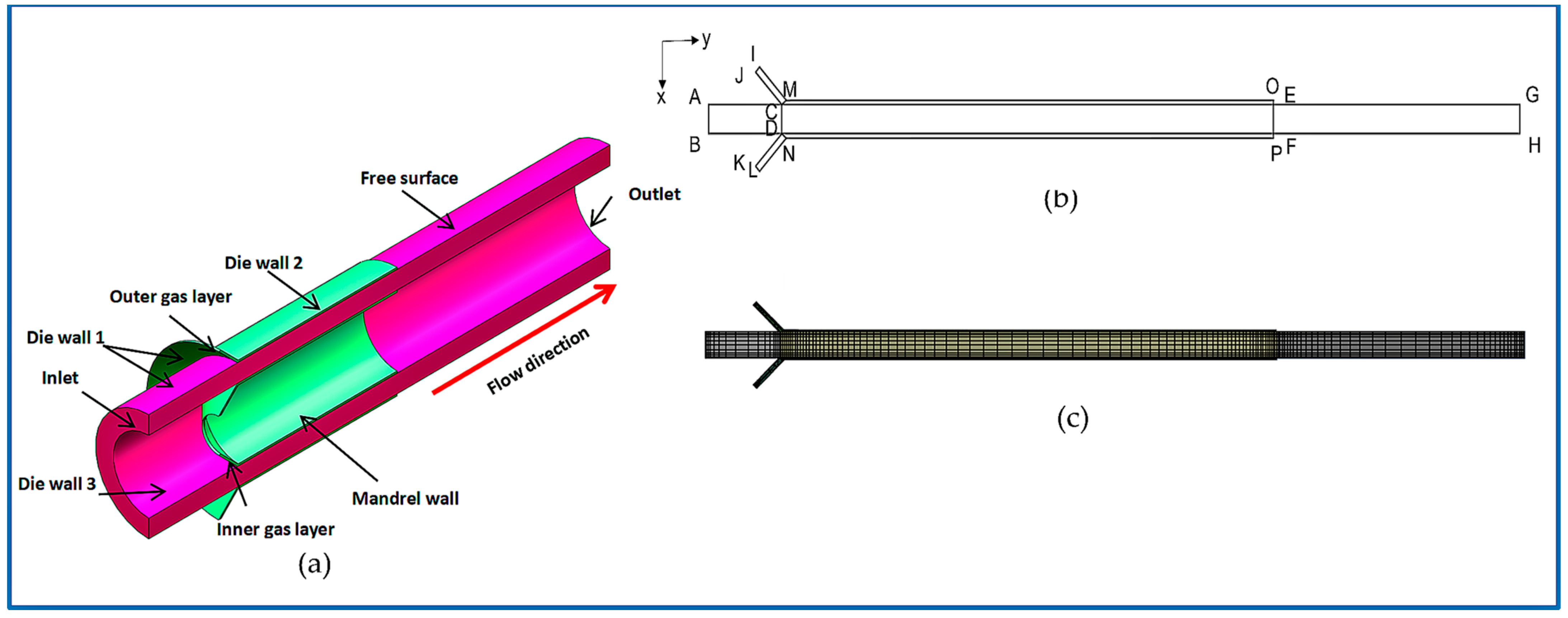
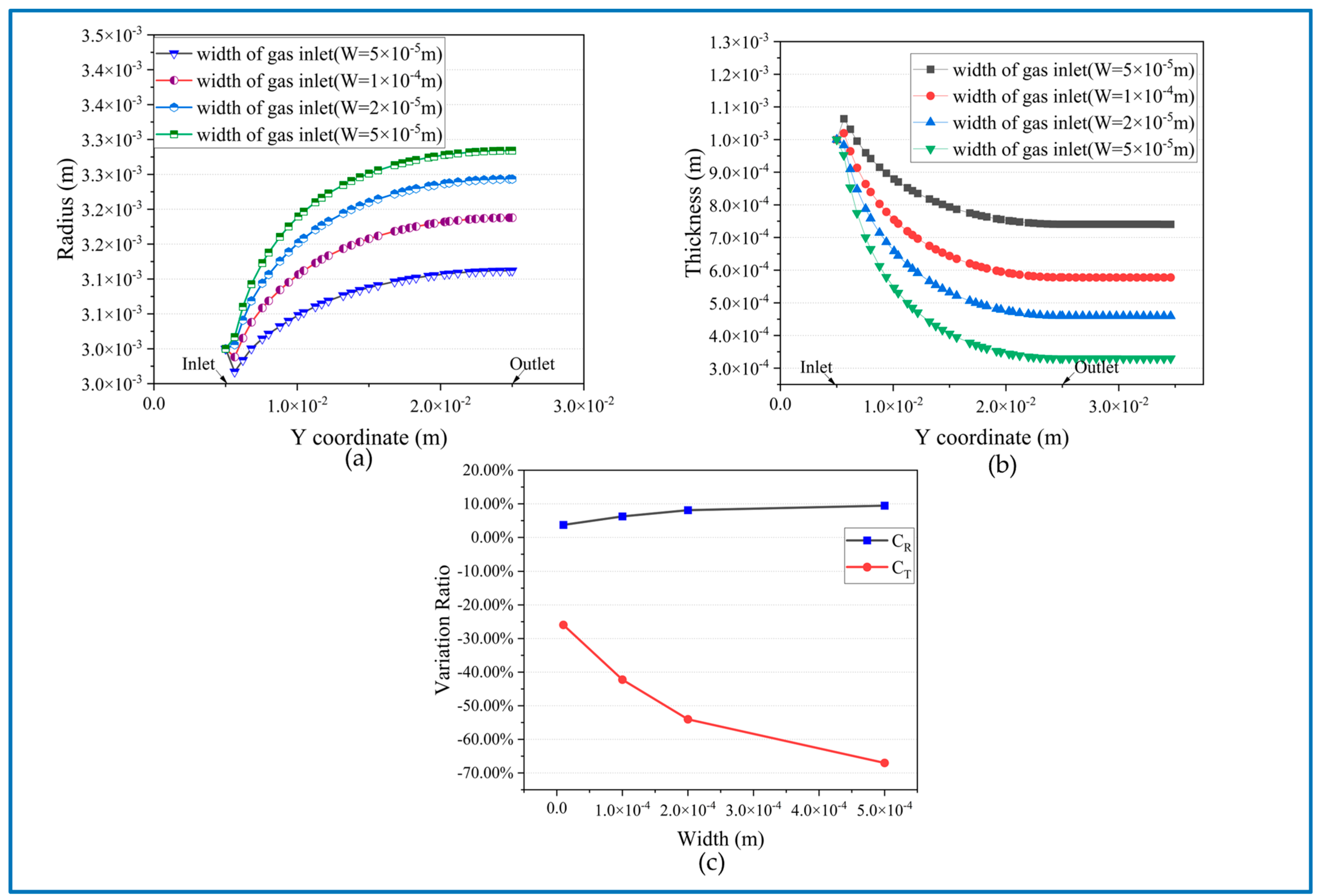
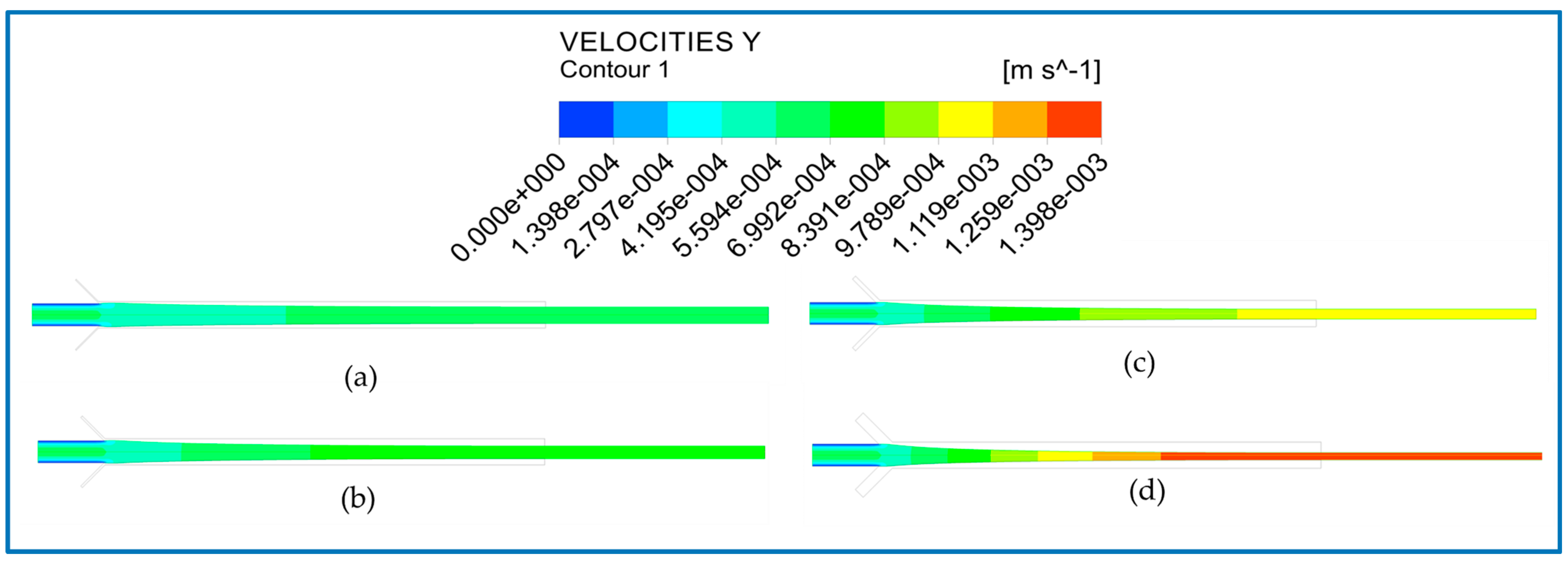
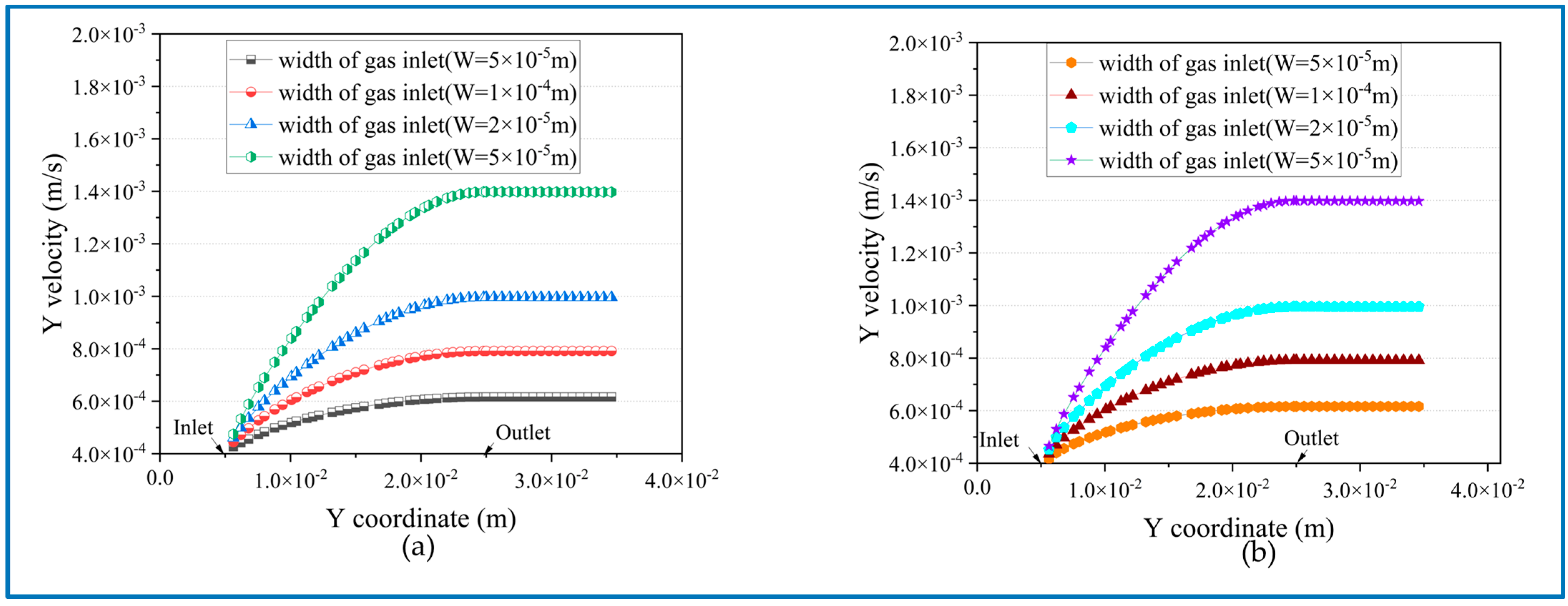
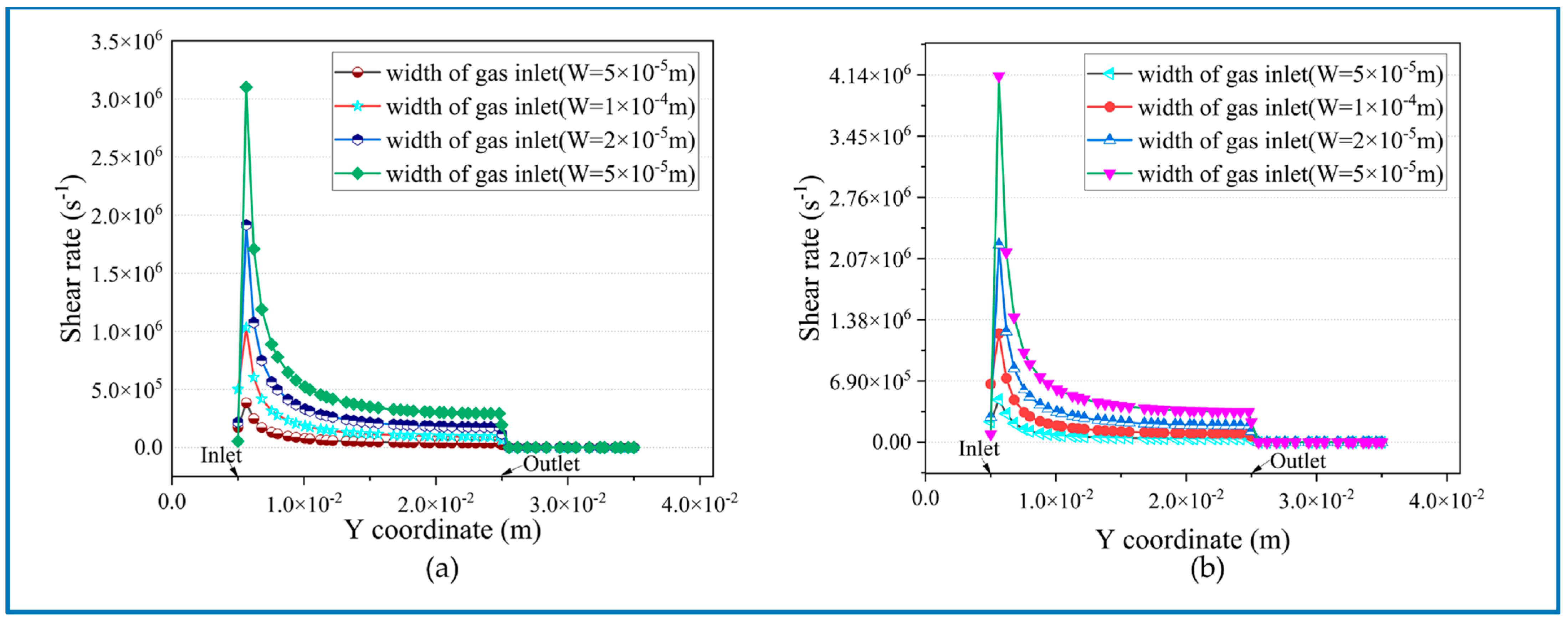
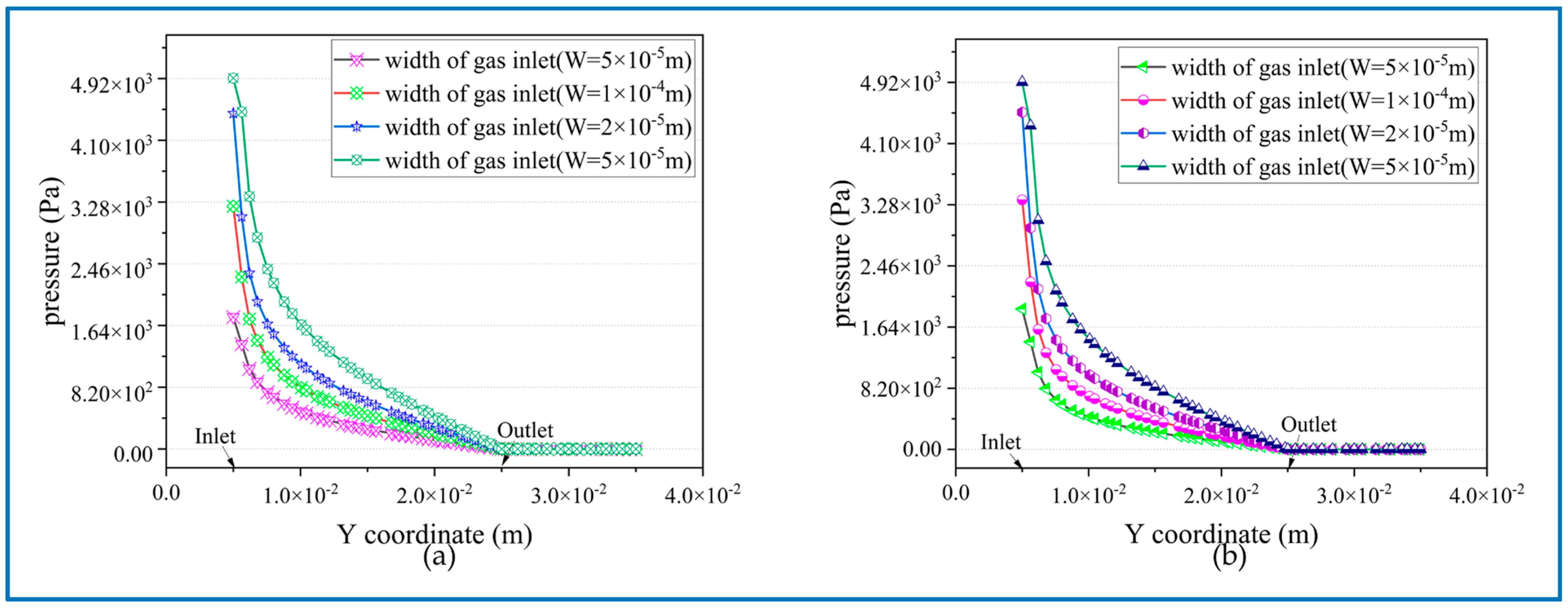
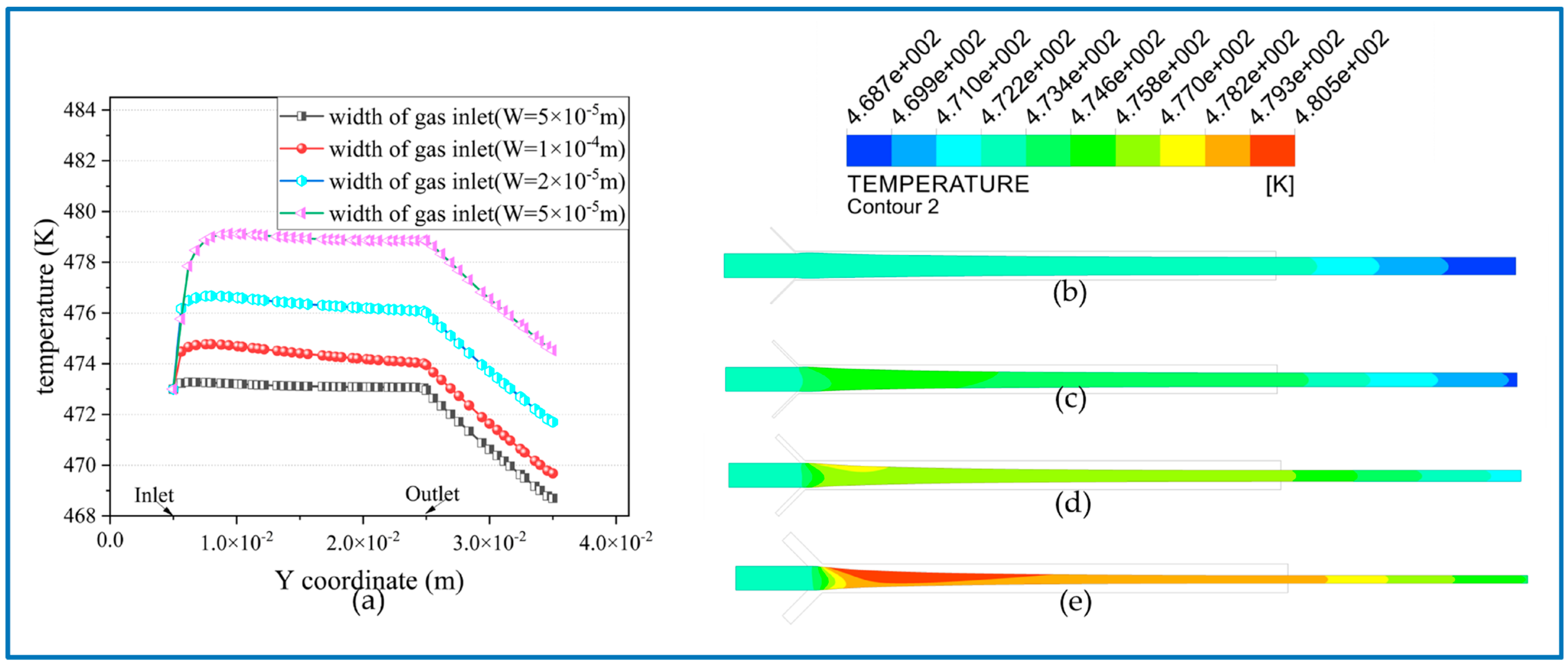
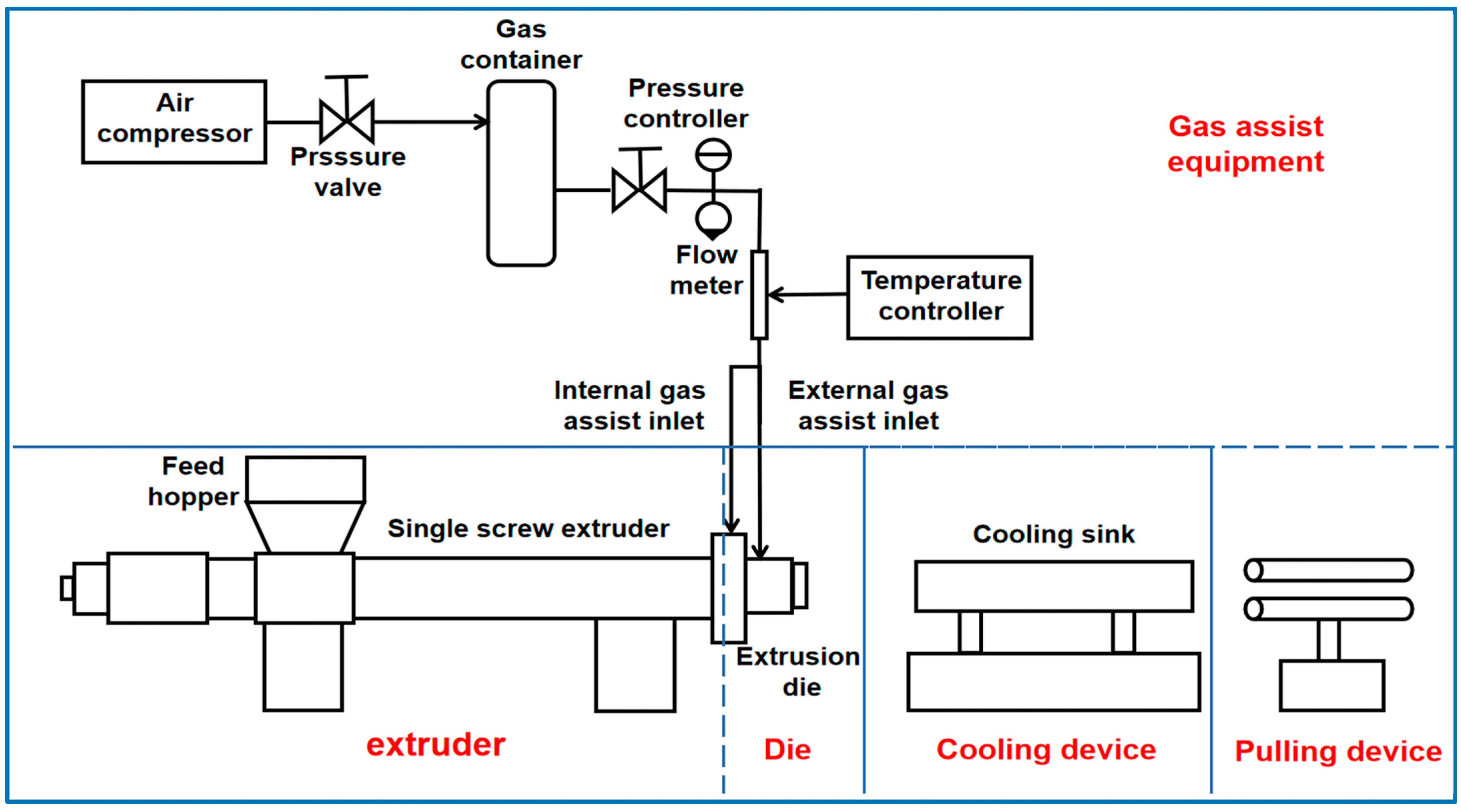
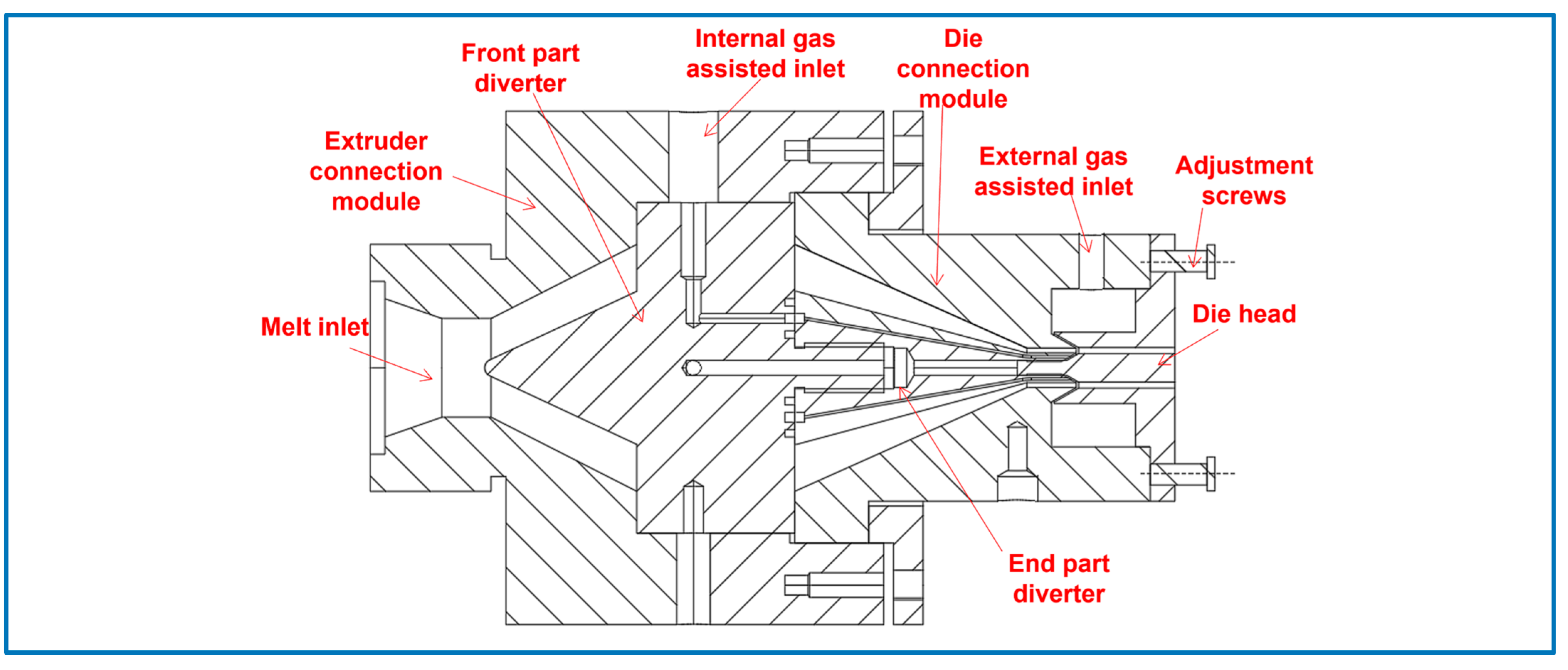
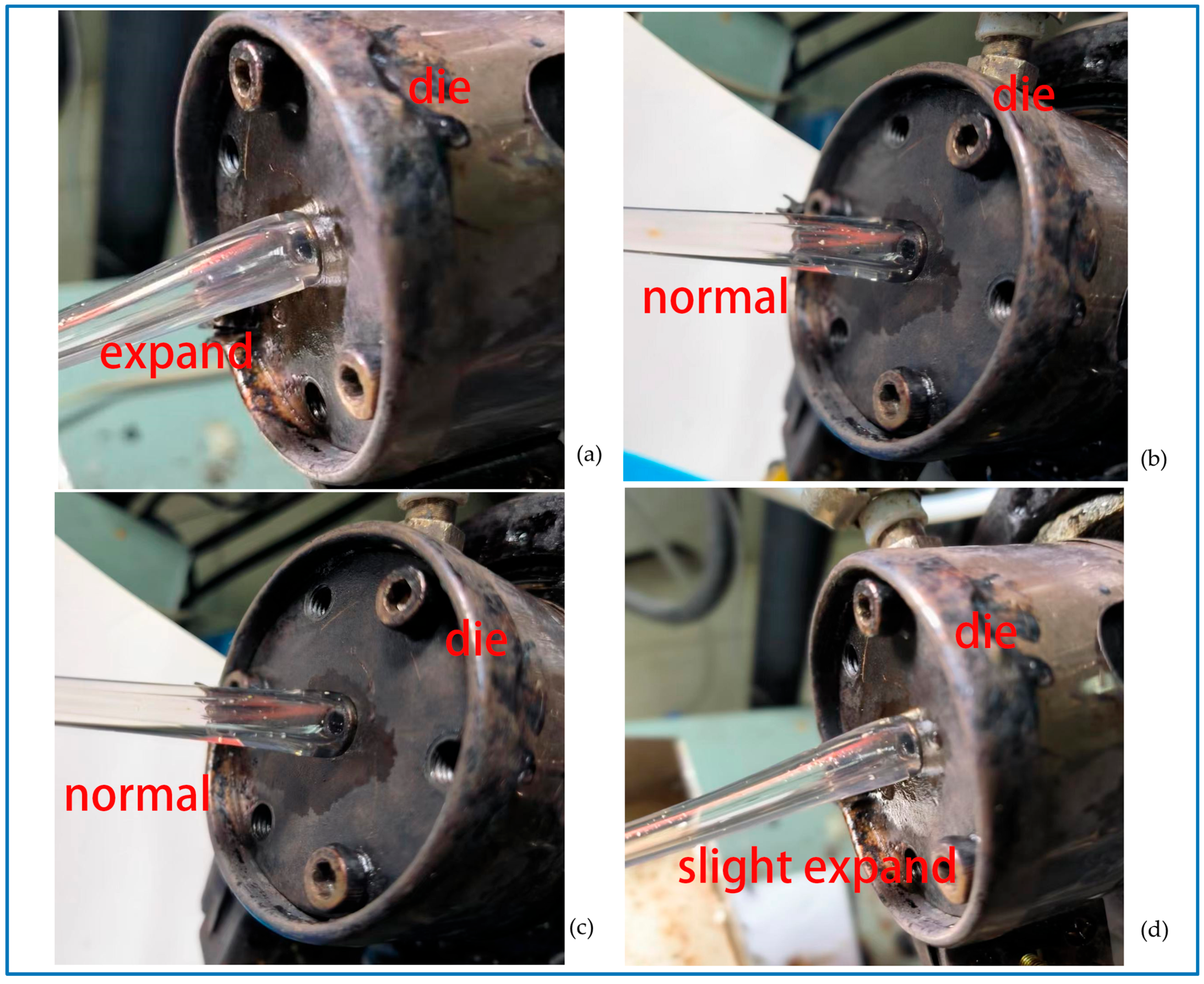
| Equation Parameters | Melt | Gas |
|---|---|---|
| η1/(Pa s) | 8823 | 2.6 × 10−5 |
| λ/(s) | 0.1 | 0 |
| ε | 0.15 | 0 |
| ξ | 0.44 | 0 |
| η1r | 0.12 | 0 |
| qk/(W·m−1·K−1) | 0.22 | 0.037 |
| CV/(J·kg−1·K−1) | 1883 | 1026 |
| Experiment Condition | Gas-Assisted Extrusion |
|---|---|
| Gas pressure/(Pa) | 5000 |
| Traction device frequency/(Hz) | 4 |
| Temperature of the die/(°C) | 200 |
| Extruder motor frequency/(Hz) | 4 |
| Gas inlet slit width (mm) | 0.05/0.1/0.2/0.5 |
| Gas Inlet Slit Width/W | Diameter (mm) | Wall Thickness (mm) |
|---|---|---|
| 5 × 10−5 m | 8.12 | 0.77 |
| 1 × 10−4 m | 7.76 | 0.62 |
| 2 × 10−4 m | 7.45 | 0.50 |
| 5 × 10−4 m | 7.84 | 0.38 |
Disclaimer/Publisher’s Note: The statements, opinions and data contained in all publications are solely those of the individual author(s) and contributor(s) and not of MDPI and/or the editor(s). MDPI and/or the editor(s) disclaim responsibility for any injury to people or property resulting from any ideas, methods, instructions or products referred to in the content. |
© 2023 by the authors. Licensee MDPI, Basel, Switzerland. This article is an open access article distributed under the terms and conditions of the Creative Commons Attribution (CC BY) license (https://creativecommons.org/licenses/by/4.0/).
Share and Cite
Chen, S.; Huang, X.; Liu, B.; Zhang, X. Influence of Gas Inlet Slit Width on Gas-Assisted Plastic Micro-Tube Extrusion. Processes 2023, 11, 2025. https://doi.org/10.3390/pr11072025
Chen S, Huang X, Liu B, Zhang X. Influence of Gas Inlet Slit Width on Gas-Assisted Plastic Micro-Tube Extrusion. Processes. 2023; 11(7):2025. https://doi.org/10.3390/pr11072025
Chicago/Turabian StyleChen, Shuiquan, Xingyuan Huang, Bin Liu, and Xiaohui Zhang. 2023. "Influence of Gas Inlet Slit Width on Gas-Assisted Plastic Micro-Tube Extrusion" Processes 11, no. 7: 2025. https://doi.org/10.3390/pr11072025
APA StyleChen, S., Huang, X., Liu, B., & Zhang, X. (2023). Influence of Gas Inlet Slit Width on Gas-Assisted Plastic Micro-Tube Extrusion. Processes, 11(7), 2025. https://doi.org/10.3390/pr11072025






